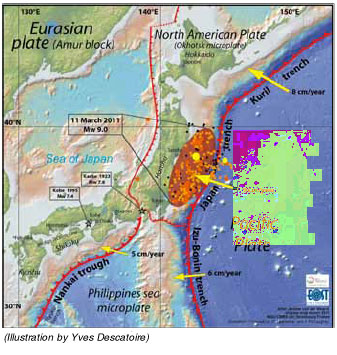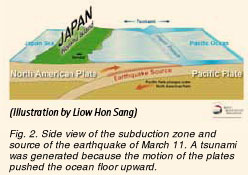|
by Jamie McCaughey and Paul Tapponnier
 apan is, by and large, well-prepared for earthquakes and tsunami. But they hadn’t been expecting an earthquake and tsunami of the size that occurred on March 11, 2011. What happened, and what can we learn from it? apan is, by and large, well-prepared for earthquakes and tsunami. But they hadn’t been expecting an earthquake and tsunami of the size that occurred on March 11, 2011. What happened, and what can we learn from it?
"The past is the key to the present and future,” to adapt a favourite axiom of earth science. Scientists apply this thinking to understand the chances of a great earthquake from any given earthquake fault; if a fault produced great earthquakes in the past, then it is likely to do so again in the future.
We have been measuring earthquakes with seismometers for just over a century. In some regions, we can also look maybe a few thousand years further back through written historical accounts of great earthquakes of the past, although that record is incomplete and sometimes vague. But how long a record do we need? Herein lies the challenge: This human time scale is but a short blip in the lifespan of an earthquake fault.
We all know that the sun will rise and set each day, but only because we have lived long enough to see it happen over and over again. In contrast, some species of fly only have a lifespan of a few hours; a fly that lives only during one part of one day would be forgiven for concluding that the world is always bright and that darkness is impossible.
Finding a longer record of past earthquakes
One way for scientists to peel back the shroud created by our short human time scale, thus revealing a true picture of earthquake hazard, is to dig into the dirt. There, layers of ancient sediments record a much longer history. By digging in the dirt in Japan a decade ago, scientists came upon a startling record - a series of thick layers of marine sand, many kilometres from the ocean, that could only have been brought there by tsunamis. Carbon dating of the deposits showed that these great tsunamis occurred about every thousand years. And to reach many kilometres inland, these tsunamis must have been generated by the largest of subduction-zone earthquakes, exactly as occurred again on March 11, 2011.
So what went wrong? Why should the March 11th event have surprised anyone? In the end, we might conclude that the disconnect was a tragic side-effect of a necessary part of the progress of science. The new findings contradicted a more long-held view among some scientists that such large earthquakes would not happen in eastern Japan. Scientists are sceptical by nature, thoroughly challenging and testing new ideas. Rightly so; scientific acceptance should rest on evidence-based conclusions that can withstand such rigorous testing, not capriciously flip from one new idea to the next. Yet this process of testing new ideas takes time - and unfortunately, March 11, 2011 came a little too quickly.
In the longer-held view, many scientists thought that the plate boundary east of Honshu would not generate large (magnitude 9) earthquakes. Within the century of instrumentally recorded earthquakes, only some subduction zones have produced large earthquakes, while others, like the one aside Honshu, had not. Could it be that some subduction zones are not capable of producing large earthquakes? Much research seemed to point toward this possibility; if earthquakes are caused by friction between converging plates (see sidebar), then perhaps the “quiet” subduction zones simply had less friction between the plates, allowing them to slide smoothly without building up enough energy to produce large earthquakes. A number of physical reasons for this possibility were suggested. For example, older ocean crust is colder and denser than young, warm oceanic crust; perhaps the old, cold, dense crust can subduct more easily, thus causing less friction between the plates and less chance to build up energy for a great earthquake. This idea not only makes intuitive sense but also has plausible physical reasons for occurring.
 But plausibility is not proof. The great East Japan earthquake of March 11, 2011 involved older oceanic crust - the kind of cold, dense crust that some had suggested could never generate a magnitude 9 earthquake. And this wasn’t the first counterexample - the devastating 2004 magnitude 9.2 Andaman-Aceh earthquake and Indian Ocean tsunami occurred in a subduction zone that some scientists had previously thought would not produce such a large earthquake. But plausibility is not proof. The great East Japan earthquake of March 11, 2011 involved older oceanic crust - the kind of cold, dense crust that some had suggested could never generate a magnitude 9 earthquake. And this wasn’t the first counterexample - the devastating 2004 magnitude 9.2 Andaman-Aceh earthquake and Indian Ocean tsunami occurred in a subduction zone that some scientists had previously thought would not produce such a large earthquake.
An earthquake that came too early
In fact, the 2002 report of evidence of ancient large earthquakes in eastern Japan did spur other scientists to look more closely into the possibility of a larger quake. More detailed studies and independent lines of evidence confirmed such a possibility. In particular, scientists in France and Japan studying the new records of the Japan-wide dense GPS network had noted that most of Honshu was stuck to the plunging Pacific plate, another sure sign that one or more great earthquakes were brewing. As of the evening of March 10, 2011, there had thus been the chance that the scientific consensus could have shifted, along with emergency planning and infrastructure, prior to the next great earthquake. But then March 11, 2011 came, tragically too soon.
Part of the challenge of drawing general conclusions about large earthquakes around the world is that there are so few well-observed cases of them to consider. Because we have observed so few, each large earthquake teaches us a great deal. Over the coming years, scientists will be very busy squaring the particulars of this earthquake with our previous understanding. We can expect that some old ideas will be discredited. We can also expect, especially given the dense network of seismometers and GPS receivers in Japan, that some revolutionary new understandings will come out. Yet not all the lessons will be given to us by new technology; some lessons were lying there in the dirt all along.
|


 apan is, by and large, well-prepared for earthquakes and tsunami. But they hadn’t been expecting an earthquake and tsunami of the size that occurred on March 11, 2011. What happened, and what can we learn from it?
apan is, by and large, well-prepared for earthquakes and tsunami. But they hadn’t been expecting an earthquake and tsunami of the size that occurred on March 11, 2011. What happened, and what can we learn from it?
 But plausibility is not proof. The great East Japan earthquake of March 11, 2011 involved older oceanic crust - the kind of cold, dense crust that some had suggested could never generate a magnitude 9 earthquake. And this wasn’t the first counterexample - the devastating 2004 magnitude 9.2 Andaman-Aceh earthquake and Indian Ocean tsunami occurred in a subduction zone that some scientists had previously thought would not produce such a large earthquake.
But plausibility is not proof. The great East Japan earthquake of March 11, 2011 involved older oceanic crust - the kind of cold, dense crust that some had suggested could never generate a magnitude 9 earthquake. And this wasn’t the first counterexample - the devastating 2004 magnitude 9.2 Andaman-Aceh earthquake and Indian Ocean tsunami occurred in a subduction zone that some scientists had previously thought would not produce such a large earthquake.
 Great earthquakes and tsunami are a long time in the making. Nine centimetres per year may not sound like much – it is about as fast as our fingernails grow. But it is also the speed at which the Pacific plate converges upon and dives beneath Japan (Fig. 1). It was the convergence of these two plates over many hundreds of years that set the stage for the sudden magnitude 9.0 earthquake of March 11.
Great earthquakes and tsunami are a long time in the making. Nine centimetres per year may not sound like much – it is about as fast as our fingernails grow. But it is also the speed at which the Pacific plate converges upon and dives beneath Japan (Fig. 1). It was the convergence of these two plates over many hundreds of years that set the stage for the sudden magnitude 9.0 earthquake of March 11.
 Click here to download the full issue for USD 6.50
Click here to download the full issue for USD 6.50